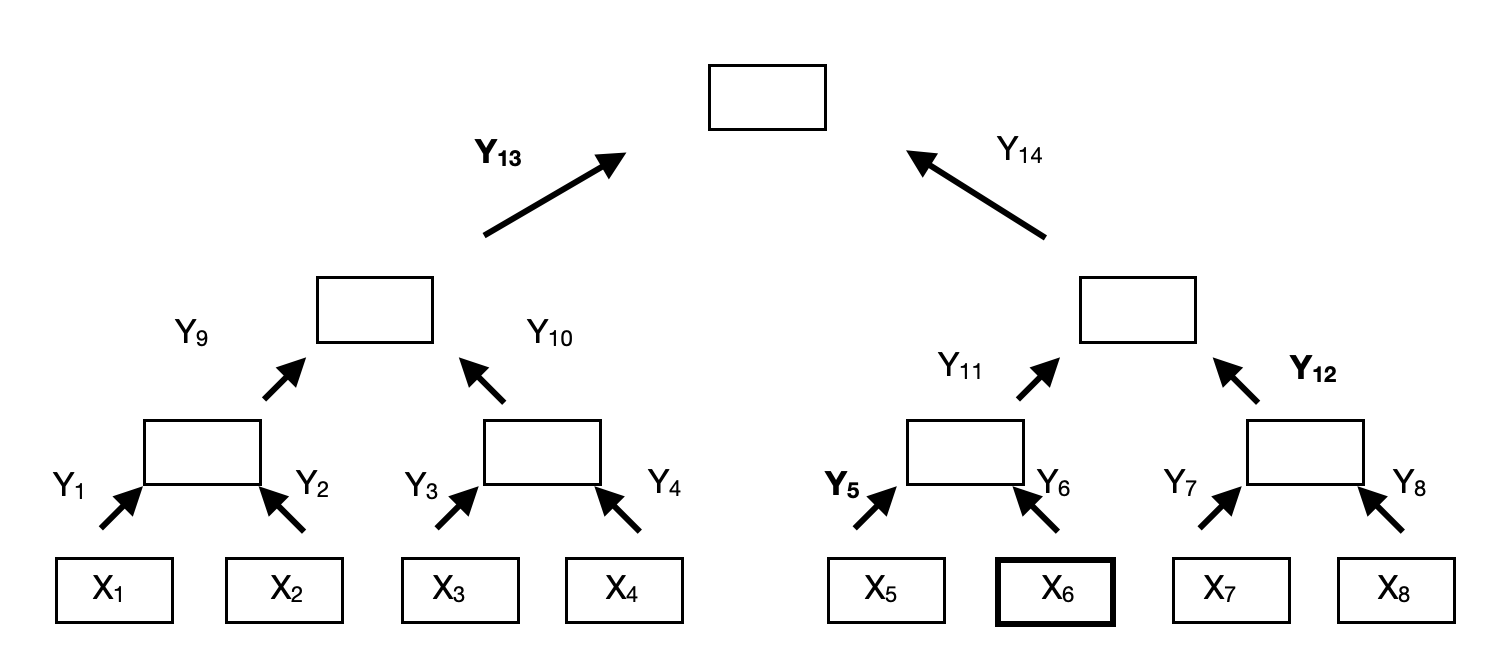Merkle Tree
Authenticated Data structures
Given a sequence of items
\[(x_1, x_2 ... x_n) := X\]an autheticated data structure is used to compute the hash \(H(X)\). Given the hash we can then prove properties using \(X\). A Merkle Tree is a form of an authenticated data structure on which we can prove membership and non-membership properties.1
Merkle Trees
The description will focus on binary merkle trees where the number of children is equal to 2. It is possible to create k-nary merkle trees.
Given \(X\) we construct a merkle tree as follows. The individual elements \(x_i \in X\) are treated as leaf nodes from which a hash \(H(x_i)\) is constructed. Given the base of the tree we then proceed by constructing parents for pairs of node \(n_1, n_2 \in N\). Let \(h_i\) denote the hash of node \(n_i\), we then create the parent for the pair by concataneting their hashes and rehashing the result \(H(h_i, h_{i+1})\). This process is repeated until only a single node is left for which the hash is the combination of all the hashes of its children. The resulting tree is depicted by the following figure.2

Membership Proof
Let us now work with the merkle tree to provide a proof that a specific \(x_6 \in X\) is part of the structure. Let \((y_{5},y_{12},y_{13}) := T\) be the set of hashes of the siblings on the path until the root node of the tree. One can then verify that \(x_6\) is part of the structure by computing
\[y^{'}_{6} := H(x_{6})\] \[y^{'}_{11} := H(y_{5}, y^{'}_{6})\] \[y^{'}_{14} := H(y^{'}_{11}, y_{12})\] \[y^{'}_{15} := H(y_{13}, y^{'}_{14})\]If \(y^{'}_{15}\) equal to \(y_{15}\) then the verifier can accept that \(x_6\) is in fact part of the structure.
A Simple Implementation In Go
The full implementation can be accessed on this github repository
Let us start by first constructing the tree structure from a set of values.
// NewTree constructs a new MerkleTree from the given values.
func NewTree(values [][]byte) *Tree {
root, leaves := construct(values)
return &Tree{
Root: root,
Leaves: leaves,
}
}
func construct(values [][]byte) (*Node, []*Node) {
leaves := make([]*Node, len(values))
for i := range leaves {
h := sha512.Sum512(values[i])
leaves[i] = &Node{
Hash: h[:],
}
}
// if the number of leaves is odd we add a duplicate
// of the last value.
if len(leaves)%2 == 1 {
h := sha512.Sum512(values[len(values)-1])
leaves = append(leaves, &Node{
Hash: h[:],
})
}
return root(leaves), leaves
}
func root(queue []*Node) *Node {
// recursively construct the parents of the pairs until only
// a single node remains which is the root of the merkle tree.
for len(queue) != 1 {
left, right := queue[0], queue[1]
queue = queue[2:]
h := sha512.Sum512(append(left.Hash, right.Hash...))
node := &Node{
Parent: nil,
Left: left,
Right: right,
Hash: h[:],
}
left.Parent = node
right.Parent = node
queue = append(queue, node)
}
return queue[0]
}
Next the implementation for the proof of the presence of a given value
type PathPoint struct {
Hash []byte
Appended bool
}
// Proof builds a proof for a MerkleTree
func (tree *Tree) Proof(h []byte) ([]PathPoint, error) {
if tree == nil {
return nil, errors.New("empty tree")
}
current := findNodeWithHash(tree.Leaves, h)
if current == nil {
return nil, errors.New("no node with such hash")
}
var path []PathPoint
// collect all the siblings until the root is reached.
parent := current.Parent
for parent != nil {
if current == parent.Left {
path = append(path, PathPoint{
Hash: parent.Right.Hash,
Appended: true,
})
} else {
path = append(path, PathPoint{
Hash: parent.Left.Hash,
Appended: false,
})
}
current = parent
parent = current.Parent
}
return path, nil
}
We can then use the merkle tree to get proofs and verify them.
func main() {
tree := merkle.NewTree([][]byte{
[]byte("x1"),
[]byte("x2"),
[]byte("x3"),
[]byte("x4"),
})
// obtain proof for x2
block := sha512.Sum512([]byte("x2"))
proof, err := tree.Proof(block[:])
if err != nil {
panic(err)
}
fmt.Println(tree.Verify())
fmt.Println(tree.VerifyProof(block[:], proof))
// obtain proof for x5
block = sha512.Sum512([]byte("x5"))
_, err = tree.Proof(block[:])
fmt.Println(err) // no node with such hash
}
Footnotes